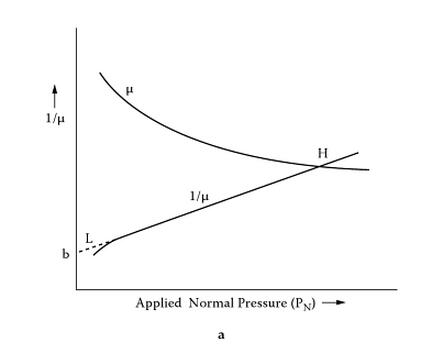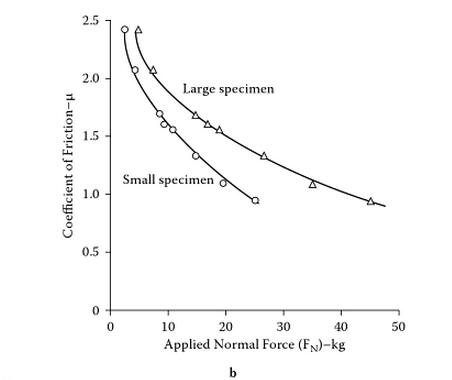Thirion reported friction test results obtained by sliding two gum rubber specimens of different sizes on smooth glass. He was apparently the first published laboratory investigator to postulate that the friction mechanism developed between rubber and a smooth surface is adhesion. Figure 3.3 presents a generalized depiction of Thirion's findings. The author experienced chattering in his initial tests and reduced sliding speed to 0.0176 cm/ sec to yield reproducible results.
As seen in Figure 3.3(a), Thirion observed that the two specimen plots were coincident when expressed in terms of PN/ and that the coefficients of rubber friction decreased hyperbolically with increasing pressure. He took an inverse approach to explain his results, proposing the following equation:
1/li = cPN + b,
Where c is a constant and b is a y-axis intercept as indicated in Figure 3.3(a).Thirion adduced that rubber friction may be expressed using two constants by extrapolating the straight-line portion (L-H) of the plotted data to zero pressure on the y-axis to obtain the y-intercept value b, together with the slope of line-segment L-H, c. Ignoring the small curved segment of his plotted data, Thirion assumed that a linear relationship between l/u and PN existed at low values of PN. Thirion postulated that the left side of Equation 3.1 indicates the inverse of u at zero pressure, while the right side of the equation represents the linearly developing rubber friction adhesion force on smooth surfaces as the pressure increases to infinity.
Figure 3.3(b) presents Thirion's data recalculated to express u vs. FN/ which again produces a hyperbolic relationship. Like the Roth et al. results, Thirion's measurements indicate that the coefficients of rubber friction for the two samples are different at the same values of applied normal load. The developed friction also appears to be area dependent in Thirion's tests.


Generalized depiction of Thirion's inverse rubber coefficient of friction (fi) approach. (Based on Thirion, P.. Rev. Gen. Caoutch., 23. 101, 1946.) (b) Coefficient of friction (u) vs. applied normal force (Calculated from Thirion, P.. Rev. (!c!n. Caoutch.. 23. 101. 1946.)




